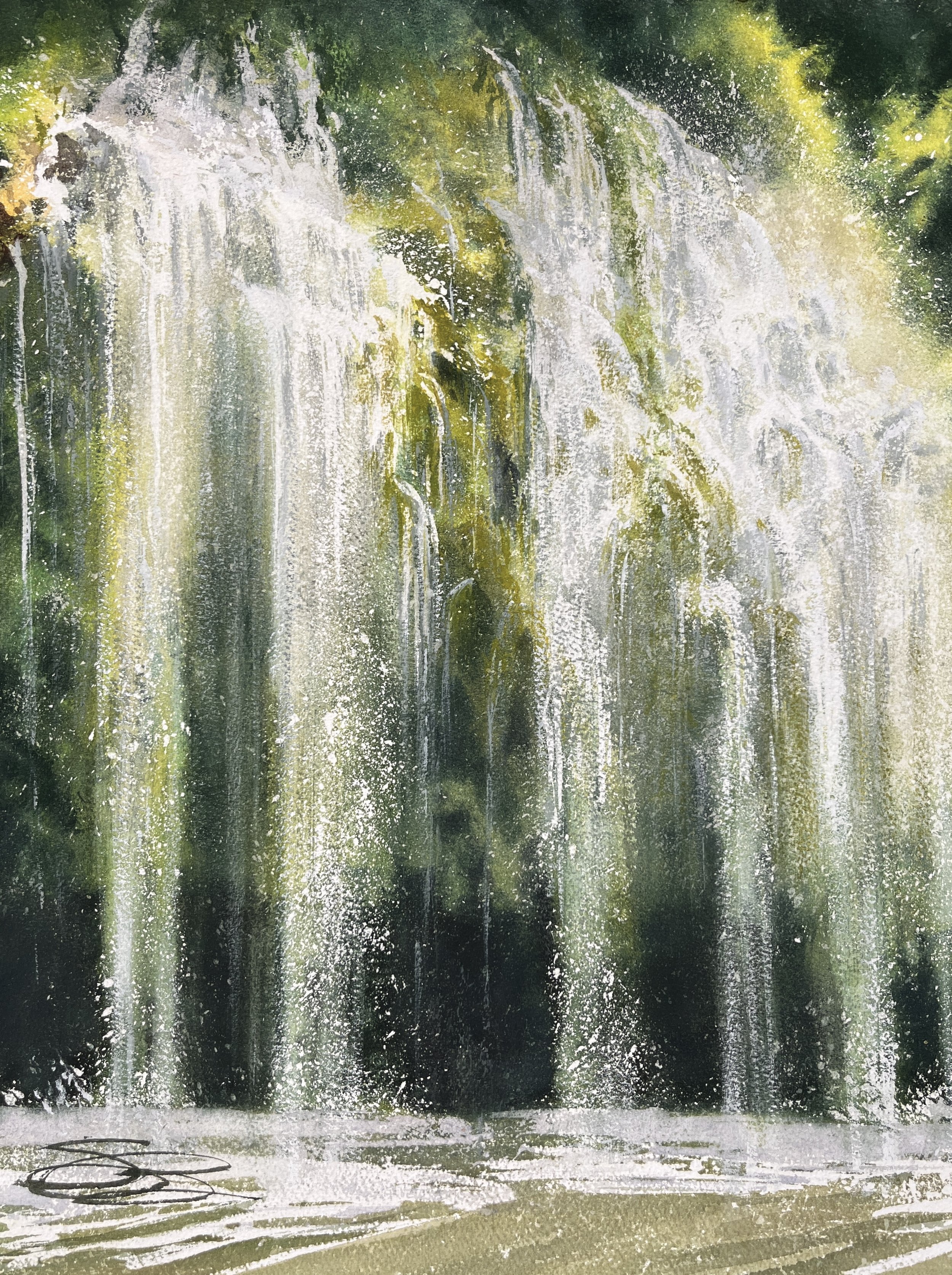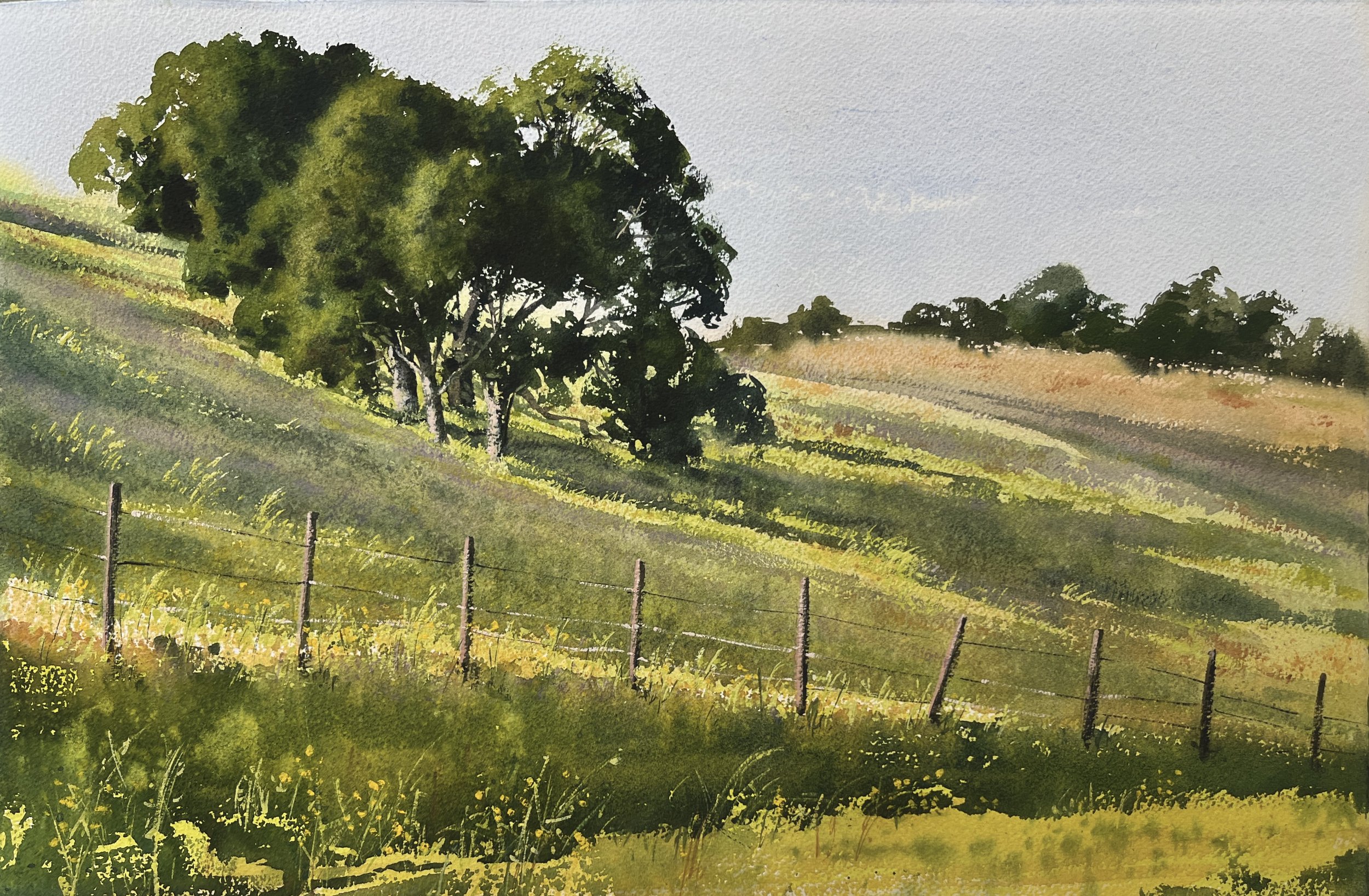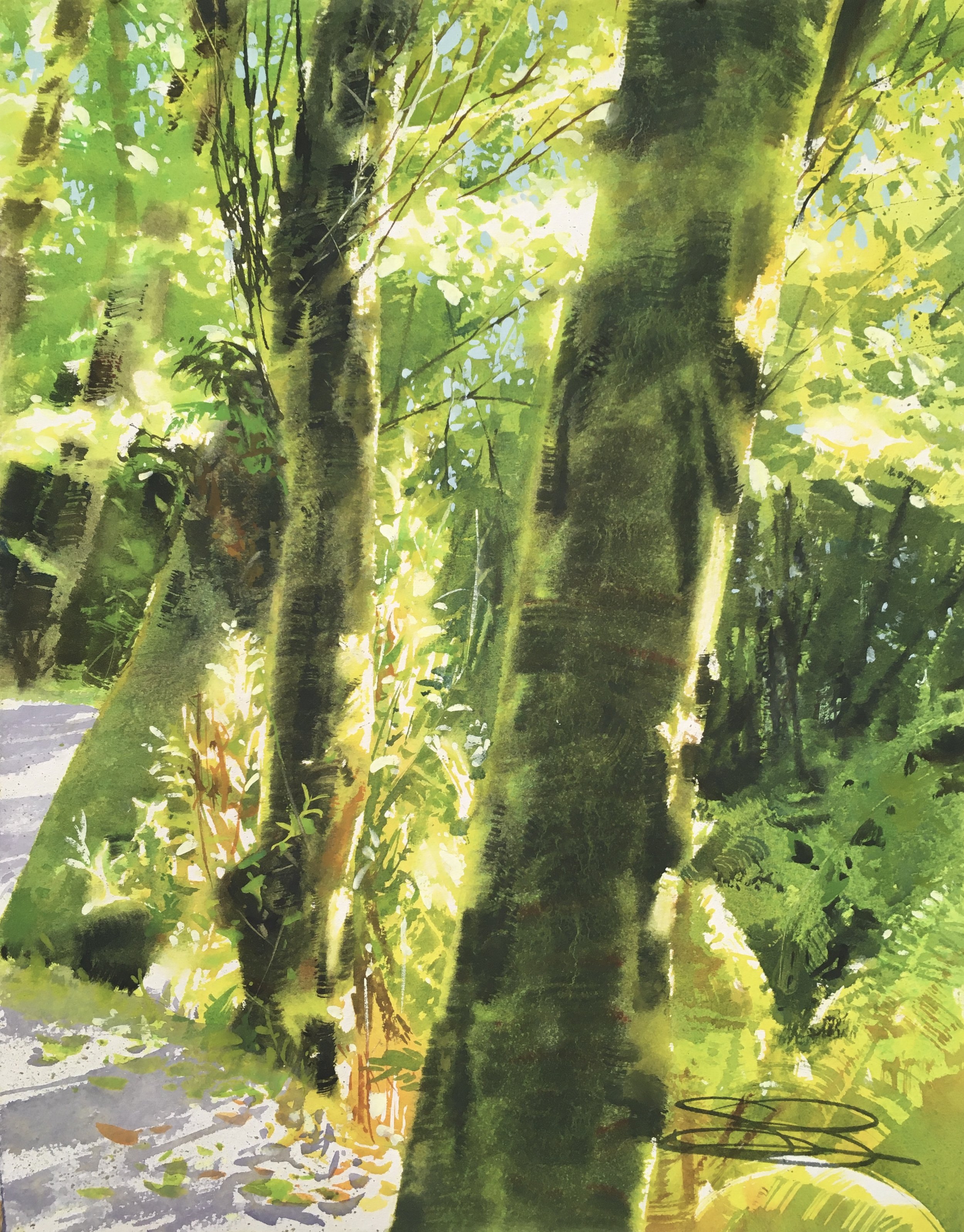How I Learn Through Artistic Experimentation, pt. 1
Mossbrae Falls, 14” x 18”
Back in early October, I shifted my weekly schedule, and began to prioritize studio painting time again— about 10 hours a week, broken up into 3-hour segments that I prescheduled weeks in advance. I was feeling good about myself, adhering to the schedule and making work consistently, not just when I could snag a few free hours. And producing some good work.
Hazy Golden Sunset, Mendocino, 22” x 30”
Rolling Hills in the Late Afternoon, 22” x 15”
North Coast Waves, Fort Bragg, 22” x 15”
Fern Canyon, 22” x 15”
However…
I also felt, underneath the studio sessions (perhaps even amplified by their consistency?), what I’ve felt growing over the last half a year— a kind of unresolved desire to open up new possibilities for myself artistically. It’s easy to fall into rendering things. And my paintings have been taking me longer. Hours longer. I get finicky sometimes. I’ve been looking for new processes to explore, new looser marks to make, more complex ways of being able to express what I’m experiencing. I decided it was time to head back into “the lab.”
And so, for the last few months, I’ve taken a pretty dedicated approach to experimentation and exploration in my studio. I’ve been quiet online, going inwards I guess. Wanting to allow myself the space to explore without explaining myself to others – perhaps not even to myself. Not having to necessarily “make sense,” but instead just to play, to test things out, to fail a lot, and to strike out into various different directions.
Last Spring, I wrote about the importance of exploration and risk taking as a part of a healthy art-diet in the post "Making Friends with Failure". And I’ve written more than once about the value of iteration as a learning tool- such as this post on “Iterative Painting" from 2016, or this one about “Iterating, with Notans and Paintings” from 2024. But as I’ve drafted this post over the last month, I recognized that there might be some value for others in explaining the details of the newer processes I’m doing, as a sort of tandem piece to those earlier posts. If “Making Friends With Failure” was about expressing the need for exploration, this post is more about the “how” of it all. The nuts and bolts of exploration. My experimental “go” bag.
The Fine Art of Finding New and Interesting Ways to Fail
Part of learning, as I see it, of teaching yourself, is to “lean away” from what you know. When I know my way too well, when I’m a little bored by the work I’m producing (even when it’s successful!), I have to go get lost for a bit. Perhaps this is the initial stage of learning? Regardless, it’s the only way I know of to produce new and different results that I can then assess for growth opportunities. And so, when I feel a sort of “artistic ennui” about what I’m producing, that I’m too much in my own company, I have to strike out and test myself and expand my limits.
Mental Approach-
First, I just want to say that, for me, this is truthfully one of the great joys of making art. Exploring brings back that excitement of “not knowing what happens next”, of paying extra-close attention and being responsive to what is happening, of dancing with the medium and letting it occasionally lead, problem solving on the fly, taking chances, and walking the highwire. There can be a real in-the-moment joy, regardless of the results.
I point that out because, logistically, there’s a 100% chance that there’s going to be more failure. LOL. It’s like mining and picking flakes of gold out of the mud in the slough. I always say this when discussing this topic, but it bares repeating— painting for 2 or 3 or 5 hours and sometimes not liking what you make sucks, but is necessary for growth. My wife is very good at noting to me that it’s not “failure” if I learn things, but shhhhh…. it still feels a lot like failure when I’m tired and cleaning up and am dissatisfied with my work. :P The learning almost always occurs later, when I have various new failures paintings to assess with a clearer mind, and rarely in the moment.
This is why I have to drum up a special mindset for this process when I enter “the lab”, a kind of fuckit-lets-go-for-it! vibe that gives me a feeling of strength and bravery. It’s something that helps me battle through a week or two of failures at a time. It always seems that a byproduct of such a mentality is that I have to dive in. If I think too much, I’ll retrace my steps and fall back into the old ruts of what I’ve always done before.
Finally, to fuel myself, underlying it all is the gentle goal, like water moving downhill, that I’m slowly becoming the artist I want to be, that I’m going to make the evocative paintings I wish I got to see elsewhere in the world. I don’t want to just be a duplicate of someone else whose work I admire. I want to be more myself. And sometimes the truth is that we don’t know exactly what that even is. Problem solving and taking chances, experimenting and critically assessing your results is, in my opinion, a big part of how you get there.
Choosing a Subject-
It seems like I have two approaches to this. But either way, I apply my experiments with forethought. The goal is to have new artistic experiences, to generate new artistic results that excite me and teach me. I personally am interested in loosening up, in choosing to lose more edges, in strong calligraphic marks with energy in them, in compelling color contrasts. So my experiments aim to activate those things.
Sometimes, I’ll deliberately pick subjects that excite me but for whom I’ve never been able figure out a way in (the waterfall, where I used splattered masking fluid). Other times, I use a new technique almost like an ignition switch. I have an idea for how I could use it, and that new process requires a new subject to test it out (the forest scene, where I painted with a scruffy flat). It’s a generative machine. Sometimes I get part way into an experimental painting and I already know it’s a throw away (the backlit redwood scene, below— which I’ve still not been able to figure out).
Technique + Style-
How do I specifically go about applying all this? For myself, I often have a running list of things I’d like to try and explore (it often includes things I’ve seen other artists use effectively but have avoided, for fear of failure!), and I tap into that list at times like this. You might like to try out something similar for yourself. My list includes things such as—
-what happens if I paint with a flat brush? (I have used rounds and mops for a decade)
-what if use a palette knife more, to both apply and remove paint? (I’ve only used one to scratch away paint)
-what if I do more scrubbing to lift paint and soften edges?
-what happens if I use more opaques for my highlights and mid values, applied thickly?
-what if I try splattering masking fluid and use it in various ways? (I’ve never particularly cared for results using masking fluid, it always seems a bit “pasted on” to me)
-what if I prewet the front as well as the back?
Results from this have been really fun. Well, mostly fun. It’s very exciting to explore and not know what you’re doing. It can force you to stop and reeeeeeeeaaaaaally pay attention to what you’re doing. LOL! Let’s jump into two examples that went well.
A Walk in the Woods-
Now first, I have to say— I normally like to throw a few of my screwups into posts like this, just to make it real for folks, but I didn’t have the forethought to photograph the final stage of those paintings I was dissatisfied with. I crumpled them up and moved on. :P But I would say that it’s been about 50/50 these last few months. For all these I’m sharing, there’s an equal amount of stutter steps, unresolved subjects, incomplete experiments, or… you know… pretty average stuff that wasn’t very exciting. Sometimes this is because of the experiment, sometimes it’s just because the subject was never going to be a good one (but I just had to scratch that itch and try it out!), and sometimes, of course, it’s just a woopsie, and I blow it.
Anyways, having said that, lets dive into some fun experiments that panned out.
A Walk in the Woods, 15” x 11”
Here I tried out using a flat for a second time. I loved it! I used very stiff, bristly flats (the Zoltan Szabo “Bristle Slant Brushes”) and how they worked was fascinating. It applies so little water, I was able to do wet into wet strokes with very little bleeding. Additionally, it’s great at lifting, which I tried as well. Splatters well too, when you flick the bristles with your finger— very controllable, because they’re so short. I knew I had those little sky holes to include too. Rather than try and paint them negatively, I mixed up gouache and cobalt blue and applied them afterwards. I loved the active strokes, which were very free.
The whole process was so fun and unexpectedly successful, I did the painting again in a bigger format!
A Walk in the Woods, 15” x 22”
Mossbrae Falls-
For this painting, I decided to come back to masking fluid, but to use it in a (for me) new and interesting way. Splatters and flicks! After all, one of my goals has been to loosen up some. Plus, I’ve seen some soft paintings done beautifully with masking fluid, where it allowed the artist paint very loose, because they knew their highlights were protected. If I could harness that, it could be valuable. Particularly because I’ve never had much success painting subjects like this.
Preliminary step with the masking fluid.
Again, I had such a blast with this, that I decided to do it again, larger. Working on these has been fun, and I can see myself doing more. Lots of different techniques coming together- not just masking fluid, but also painting with a flat, using opaques late in the game, and some scrubbing to soften and lift edges. Much like with the meadow I painted last Spring (read about it here), the goal with many of these processes has been to integrate the preserved whites through scrubbing, lifting, adding more whites, opaques, etc. Distressing the input, essentially.
Mossbrae Falls, 14” x 18”
In the next post, I’ll share another method I’ve tried out— intentionally exploring elements of other painters I like. Here I ponder why I like that thing they do so much, and if there’s a way to steal it and integrate that into my own work. This has been a really interesting process, and has led to some compelling color and texture experiments, as I’ve explored Gustav Klimt’s use of texture and pattern and Paul Evan’s use of color in their landscapes. More on that in the next post!











